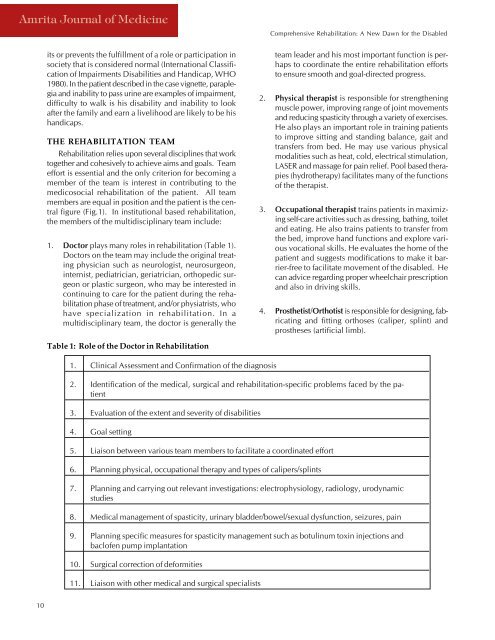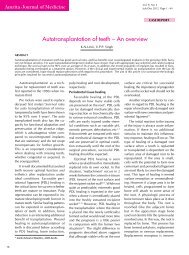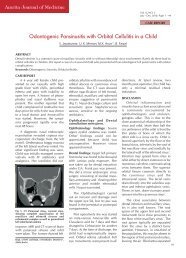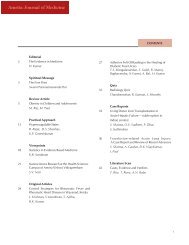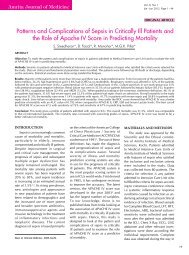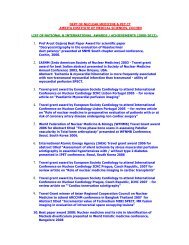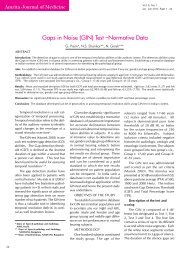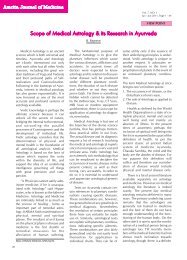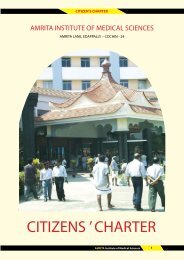Journal of Medicine Vol 4 - Amrita Institute of Medical Sciences and ...
Journal of Medicine Vol 4 - Amrita Institute of Medical Sciences and ...
Journal of Medicine Vol 4 - Amrita Institute of Medical Sciences and ...
You also want an ePaper? Increase the reach of your titles
YUMPU automatically turns print PDFs into web optimized ePapers that Google loves.
<strong>Amrita</strong> <strong>Journal</strong> <strong>of</strong> <strong>Medicine</strong><br />
Comprehensive Rehabilitation: A New Dawn for the Disabled<br />
its or prevents the fulfillment <strong>of</strong> a role or participation in<br />
society that is considered normal (International Classification<br />
<strong>of</strong> Impairments Disabilities <strong>and</strong> H<strong>and</strong>icap, WHO<br />
1980). In the patient described in the case vignette, paraplegia<br />
<strong>and</strong> inability to pass urine are examples <strong>of</strong> impairment,<br />
difficulty to walk is his disability <strong>and</strong> inability to look<br />
after the family <strong>and</strong> earn a livelihood are likely to be his<br />
h<strong>and</strong>icaps.<br />
THE REHABILITATION TEAM<br />
Rehabilitation relies upon several disciplines that work<br />
together <strong>and</strong> cohesively to achieve aims <strong>and</strong> goals. Team<br />
effort is essential <strong>and</strong> the only criterion for becoming a<br />
member <strong>of</strong> the team is interest in contributing to the<br />
medicosocial rehabilitation <strong>of</strong> the patient. All team<br />
members are equal in position <strong>and</strong> the patient is the central<br />
figure (Fig.1). In institutional based rehabilitation,<br />
the members <strong>of</strong> the multidisciplinary team include:<br />
1. Doctor plays many roles in rehabilitation (Table 1).<br />
Doctors on the team may include the original treating<br />
physician such as neurologist, neurosurgeon,<br />
internist, pediatrician, geriatrician, orthopedic surgeon<br />
or plastic surgeon, who may be interested in<br />
continuing to care for the patient during the rehabilitation<br />
phase <strong>of</strong> treatment, <strong>and</strong>/or physiatrists, who<br />
have specialization in rehabilitation. In a<br />
multidisciplinary team, the doctor is generally the<br />
team leader <strong>and</strong> his most important function is perhaps<br />
to coordinate the entire rehabilitation efforts<br />
to ensure smooth <strong>and</strong> goal-directed progress.<br />
2. Physical therapist is responsible for strengthening<br />
muscle power, improving range <strong>of</strong> joint movements<br />
<strong>and</strong> reducing spasticity through a variety <strong>of</strong> exercises.<br />
He also plays an important role in training patients<br />
to improve sitting <strong>and</strong> st<strong>and</strong>ing balance, gait <strong>and</strong><br />
transfers from bed. He may use various physical<br />
modalities such as heat, cold, electrical stimulation,<br />
LASER <strong>and</strong> massage for pain relief. Pool based therapies<br />
(hydrotherapy) facilitates many <strong>of</strong> the functions<br />
<strong>of</strong> the therapist.<br />
3. Occupational therapist trains patients in maximizing<br />
self-care activities such as dressing, bathing, toilet<br />
<strong>and</strong> eating. He also trains patients to transfer from<br />
the bed, improve h<strong>and</strong> functions <strong>and</strong> explore various<br />
vocational skills. He evaluates the home <strong>of</strong> the<br />
patient <strong>and</strong> suggests modifications to make it barrier-free<br />
to facilitate movement <strong>of</strong> the disabled. He<br />
can advice regarding proper wheelchair prescription<br />
<strong>and</strong> also in driving skills.<br />
4. Prosthetist/Orthotist is responsible for designing, fabricating<br />
<strong>and</strong> fitting orthoses (caliper, splint) <strong>and</strong><br />
prostheses (artificial limb).<br />
Table 1: Role <strong>of</strong> the Doctor in Rehabilitation<br />
1. Clinical Assessment <strong>and</strong> Confirmation <strong>of</strong> the diagnosis<br />
2. Identification <strong>of</strong> the medical, surgical <strong>and</strong> rehabilitation-specific problems faced by the patient<br />
3. Evaluation <strong>of</strong> the extent <strong>and</strong> severity <strong>of</strong> disabilities<br />
4. Goal setting<br />
5. Liaison between various team members to facilitate a coordinated effort<br />
6. Planning physical, occupational therapy <strong>and</strong> types <strong>of</strong> calipers/splints<br />
7. Planning <strong>and</strong> carrying out relevant investigations: electrophysiology, radiology, urodynamic<br />
studies<br />
8. <strong>Medical</strong> management <strong>of</strong> spasticity, urinary bladder/bowel/sexual dysfunction, seizures, pain<br />
9. Planning specific measures for spasticity management such as botulinum toxin injections <strong>and</strong><br />
bacl<strong>of</strong>en pump implantation<br />
10. Surgical correction <strong>of</strong> deformities<br />
11. Liaison with other medical <strong>and</strong> surgical specialists<br />
10


